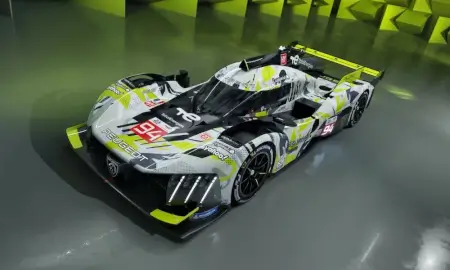April 19th 2024
Peugeot's new-spec 9X8 Hypercar ready for Imola debut
After Alpine, Lamborghini and Isotta Fraschini debuted their brand new WEC Hypercars at the season-opener in Qatar last month, for this weekend’s race in Imola it’s Peugeot’s turn. With the 2024-spec 9X8 now homologated and ready to go following an extensive track test program that began last December, the French team is eager to show off the developments to its package, which it hopes will transform it from an also-ran to a contender.
With the 2024 9X8, Peugeot has moved away from its radical wingless design, which generated the bulk of its downforce via underfloor aero and switched to the now-standard Hypercar tire size, with narrower fronts and wider rears.
Rowing back on its initial concept was a major decision for Peugeot’s effort in the WEC, and left its engineering staff with a colossal task to complete in a matter of months. You could argue that choosing to conduct a ground-up redesign of this car was almost as bold and radical as its plan to compete in the WEC with such an unconventional design in the first place.
After successfully campaigning to use a ‘Joker’ upgrade this substantial following lengthy discussions with the rule-makers, the only carryover elements from the previous iteration are the tub, windscreen, air intake, cooling ducts, engine, gearbox and hybrid system. Practically every surface on the car is new – 90 per cent to be more precise – resulting in a car that, upon closer inspection, looks and feels more like a traditional sports prototype than its predecessor.
Since it first hit the track last December, the new 9X8 has completed a whopping 15,000 kilometres of running at a number of circuits in Europe including Le Castellet, Portimao and Aragon. The focus throughout, Peugeot driver Loic Duval told RACER, was more on durability rather than performance.
The previous-gen 9X8, particularly early on, suffered from a suite of reliability woes. Over a series of small developments the major concerns, such as the issues stemming from the car’s gearbox, were solved. But it was never perfect. This left the team with a car that proved to be very track-sensitive and tricky to balance against the more conventional cars in the class via BoP.
More often than not the original 9X8 flattered to deceive. It failed to win a single race and only briefly showed flashes of front-running pace, notably at Le Mans in changeable conditions, at Monza a month later and in its final outing at Qatar back in March before the lead car ran out of fuel while battling for the lead.
So, with the testing and development phase in the books and the car mere days away from its first race, the questions now are: Will this change in approach work and how quickly can the team get up to speed if this car proves to be a significant improvement?
On the reliability side of things, Peugeot Sport technical director Olivier Jansonnie wouldn’t go into detail but confirmed that testing had not been trouble-free. “But it never is,” he chuckled. “It’s a tough preparation that we are doing, endurance testing for about two days, with more track time than you would see at Le Mans, because the average track speed is not the same.
“With that, you will find some issues, some small that you will fix easily, and some that require a bit more work. But generally, we are for sure better prepared than we were this time last year.”
Duval added that he too can’t say at this stage whether the car will prove to be ‘bulletproof’ when it’s taken to the track in anger this Sunday for six hours on the tight, technical Imola circuit.
“We had many issues last year, then it was better in the second half of the season,” he reflected. “But a lot of resources have been put towards changing concepts. And because of that, we can’t put all our resources into fixing reliability problems. I can’t tell you that we won’t have issues, we are not in that position yet.”
However, where Peugeot and its driver roster are more confident is in the steps the car has made in drivability. RACER polled a selection of drivers quietly during the car’s testing phase and on the record today in Italy. The feedback was and continues to be universally positive in this area.
Driver Mikkel Jensen, when asked about the magnitude of the changes in terms of the feel of the car, said: “It’s a big step. The rear of the car is more planted, we are not having to manage it as much on corner exit, we have more confidence in both the performance and in managing the tyres for longer.”
Jansonnie added that much of the progress comes via the change in tyre size, which he feels cannot be overstated. “Everything was driven by the decision to change the tyre size,” he said.
Duval echoed this, telling RACER that from a driver’s perspective it has had a “massive effect” on the car.
“I really believed that last year’s tire size had a negative effect on traction. Now, you don’t overheat the tires and that means you feel more consistency,” he continued.
“We have a bigger contact patch, which means we can carry more speed on entry and through corners and be more aggressive with the throttle. There is more compliance with the rear axle in general. The power delivery is the same, it’s just that you can use it better.
“However, one thing that is different is the activation of the hybrid system (the speed at which it kicks in and drives the front axle). It has changed from 130 kph to 190 kph like the others (using LMH chassis). Even though deployment at the front comes later on, you gain support from the tires at the rear.
“Overall the car is more predictable through stints, it suffers less of a drop in pace. And best of all it’s early, we still have a lot to learn with the car in terms of set-up.”
He also revealed that the car’s previous issues in straight-line speed have been reduced too. Crucially, this should stand the car in good stead for the most important race of the year at the Circuit de la Sarthe in June, a track that the 9X8 was strong at last year, leading a considerable chunk of the centenary Le Mans 24 Hours.
“It’s funny because even though we had no rear wing last year we discovered that we were slow in a straight line compared to our competitors,” he explained. “Last year we had a lot of drag, with big gurneys on the engine cover and behind the exhaust. They were not ideal.”
Where Peugeot now lags behind the competition, clearly, is race experience with the car. It hasn’t yet been able to focus on fighting for the final tenths in performance terms or analyze its performance up against the other cars in Hypercar. As such, expectations are being kept realistic for this weekend
“As a racer, I want to win and be on the podium,” Duval summarized. “But now with BoP, and the new car, I have no idea where we are.
“We know we have made steps, we can compare this car with the old one in the same conditions. We are on the right path, but I don’t know how we will fare against the competition.”
For more information: www.racer.com
For more Industry News, please Click Here











